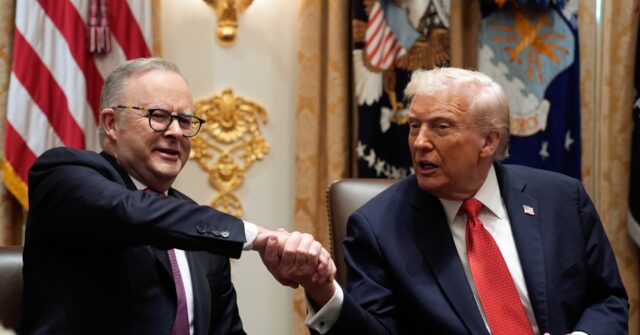President Donald Trump signed a critical minerals deal with Australian Prime Minister Anthony Albanese on Monday, a team-up explicitly intended to break China’s near-monopoly on mining and refining the valuable resources.
The agreement committed the U.S. and Australia to invest over a billion dollars each over the next six months into mining projects and refineries. The deal also set a minimum price for critical minerals.
The White House said the U.S. Export-Import Bank (EXIM Bank) would make up to $5 billion in financing available for mineral projects. Albanese said projects valued at roughly $8.5 billion would soon be up and running, giving the U.S.-Australian partnership access to mineral deposits worth up to $53 billion.
Albanese noted the agreement is more of an “action plan” than a binding agreement with “enforceable obligations,” but he and Trump predicted the allure of critical minerals was so great that American and Australian industries would require no government urging to exploit the opportunities created by the deal.
“In about a year from now, we’ll have so much critical minerals and rare earths that you won’t know what to do with them,” President Trump enthused. “We’re really working on anything having to do with military, military protection, military ships, vehicles, guns, ammunition, everything.”
“Increasing the security for the region and our economic relationship is so important. Today’s agreement on critical minerals and rare earths is just taking it to the next level, seizing those opportunities which are before us,” said Albanese.
“Critical minerals” are an expansive group that includes the much-discussed “rare earth minerals,” plus others deemed critical to energy and defense technology, such as lithium and cobalt. The U.S. Secretary of the Interior, Department of Energy (DOE), and U.S. Geological Survey (USGS) are responsible for updating America’s list of critical minerals.
One criteria for critical minerals is supply chain vulnerability – and that makes today’s list quite long indeed,because China dominates the supply chain for nearly all of them. Not only do Chinese mines produce about 70 percent of rare earth minerals, and Beijing controls 90 percent of the worldwide refining capacity.
China is the dominant producer of most other critical minerals as well, thanks in part to Beijing’s aggressive use of its Belt and Road Initiative (BRI) to snap up mineral rights in developing countries over the past decade.
The Chinese build mines and refineries at a pace the rest of the world cannot hope to match because China does not hamstring its development efforts with elaborate environmental regulations and labor laws. When companies from other nations express interest in making the huge investments necessary to develop refining capacity, China tends to respond by flooding the market with minerals, driving prices down and making those massive up-front startup investments look less appealing.
This is why the U.S. mining industry wanted the minimum price floors established in Trump’s deal with Albanese. American industry is hungry for minerals like cobalt, and the U.S. has sizable cobalt deposits ready for the taking, but China’s price control tactics have made it all but impossible for American corporations to run cobalt mines at a profit.
The pricing floor will also force Western policymakers to face the uncomfortable truth that China keeps its prices down by inflicting environmental damage and human-rights horrors that would be unthinkable for American or European operations.
Clean and sustainable supplies come at a premium. The Western political elite, supposedly obsessed with climate change and environmental concerns, has chosen to outsource ecological devastation to Chinese industry – and look the other way, as long as China supplies minerals at steep discounts.
Western leaders are well aware of the dangers of letting China dominate supply chains for the minerals that fuel high-tech industry, especially as Beijing has repeatedly demonstrated its willingness to manipulate supply to achieve its political goals.
Australia’s government and mining industry began mounting a serious challenge to Chinese dominance in 2022, after a huge deposit of rare earth minerals was discovered in central Australia. South Korea, another nation hungry for rare earths, quickly signed deals to develop Australian production.
In June, the Group of Seven nations (G7) rolled out an action plan for “de-risking” critical mineral supply chains. The plan avoided mentioning China by name, but was clearly designed to reduce Beijing’s leverage over the world’s mineral supply.
“We recognize that non-market policies and practices in the critical minerals sector threaten our ability to acquire many critical minerals, including the rare earth elements needed for magnets, that are vital for industrial production,” said the G7 statement issued in June. There is no one else the statement could have been talking about than China.
Albanese said on Monday that one of the new rare earths processing projects covered by the deal with Trump will be a joint U.S.-Australian-Japanese venture. Another will be a massive gallium refinery constructed in partnership with the Pentagon, which needs gallium to manufacture the semiconductors used by advanced military equipment. The new project is expected to meet up to 13 percent of the world’s gallium needs when completed. China currently controls 99% of the gallium supply.
U.S. and Australian officials noted that speed is an essential component of the critical minerals plan, with expedited financing and permitting intended to make production of useful materials begin before China has time to react to the plan. Mining industry experts approved of this approach, noting that for all of its formidable advantages, China has trouble acting within the six-month and one-year timetables envisioned by the Trump-Albanese deal.
Read the full article here
